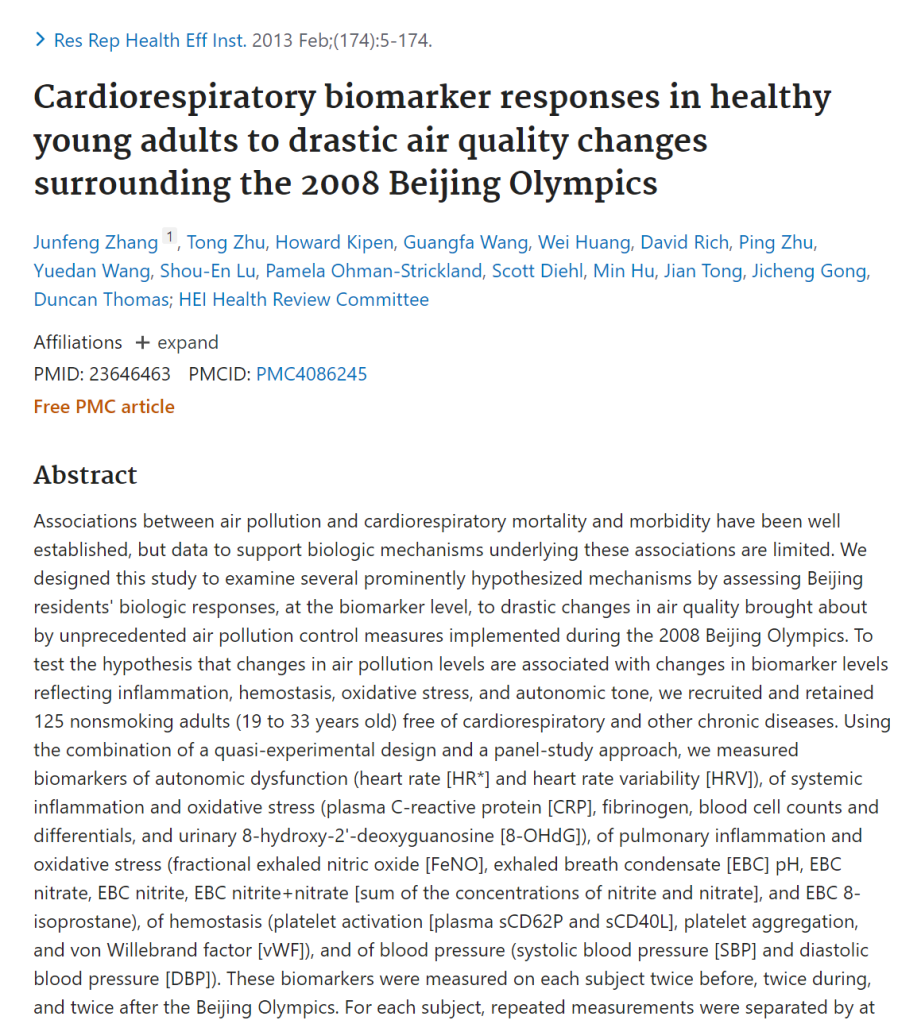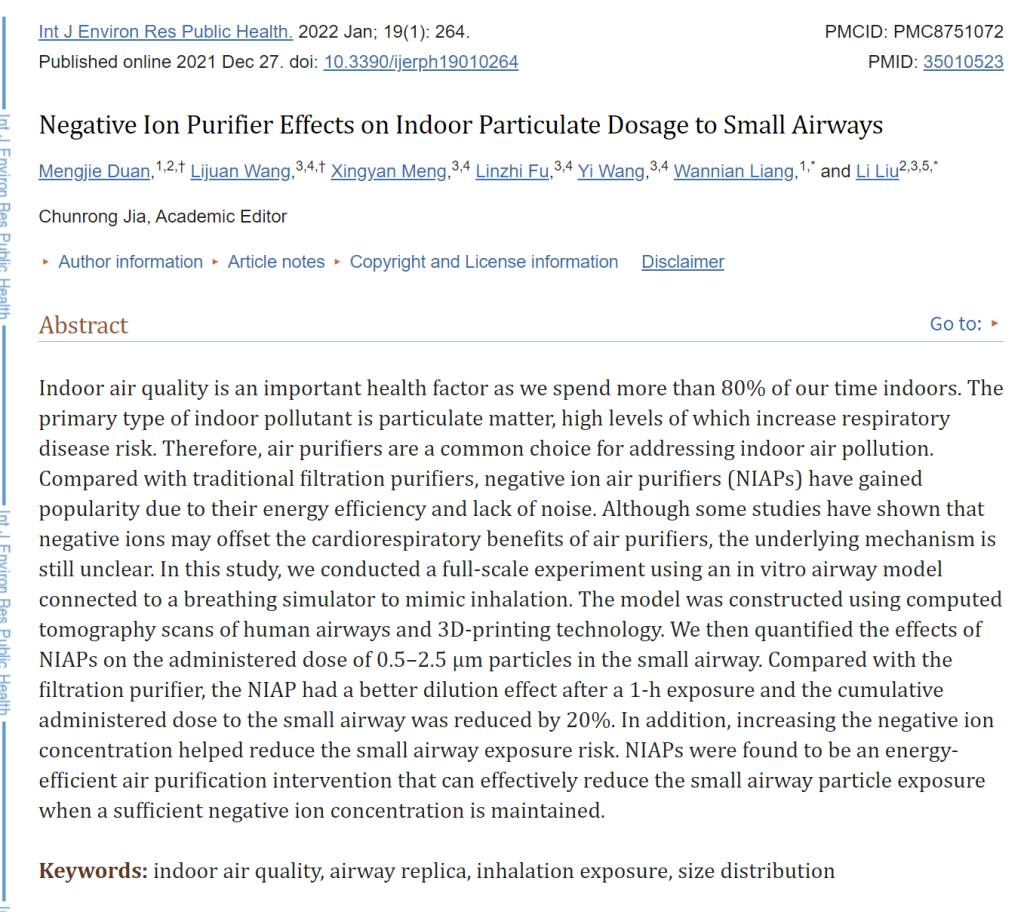
Anions/Negative Ions Science, videos and articles
Several of Prife Internationals products have Anions – another name for negative ions. Here you find some studies, videos and articles about anions and what they can do.
Read more about the IONSheild
Read more about the iTeraBio
Read more about the iTeraCare

Negative ions offset cardiorespiratory benefits of PM2.5 reduction from residential use of negative ion air purifiers
Negative ion air purifiers (NIAPs), as a less costly alternative to the HEPA filtration, have been increasingly deployed in China and potentially elsewhere. While reducing indoor concentrations of fine particulate matter (PM2.5), NIAPs generate massive amounts of negative ions that may be of health concern. We performed week-long interventions with NIAPs in the dormitories of 56 healthy college students living in Beijing. In a randomized order, each student underwent a true and a sham NIAP session. Cardiorespiratory outcomes were measured before and after each session. The use of true NIAPs reduced indoor PM2.5 concentrations significantly, while notably increased negative ion levels. Increases in PM2.5 and negative ion (NI) exposure were independently associated with increased urinary concentration of malondialdehyde, a biomarker of systemic oxidative stress, resulting in a null net effect of NIAP on malondialdehyde. Likewise, no significant net effects of NIAPs were observed for other outcomes indicative of lung function, vascular tone, arterial stiffness, and inflammation. Our findings suggest that negative ions, possibly along with their reaction products with the room air constituents, adversely affect health. The downsides do not support the use of NIAPs as a health-based mitigation strategy to reduce PM2.5 exposure, especially in residences with PM2.5 concentrations that are not extremely high.
Read more here

Cardiorespiratory biomarker responses in healthy young adults to drastic air quality changes surrounding the 2008 Beijing Olympics

Negative Ion Purifier Effects on Indoor Particulate Dosage to Small Airways
Indoor air quality is an important health factor as we spend more than 80% of our time indoors. The primary type of indoor pollutant is particulate matter, high levels of which increase respiratory disease risk. Therefore, air purifiers are a common choice for addressing indoor air pollution. Compared with traditional filtration purifiers, negative ion air purifiers (NIAPs) have gained popularity due to their energy efficiency and lack of noise. Although some studies have shown that negative ions may offset the cardiorespiratory benefits of air purifiers, the underlying mechanism is still unclear. In this study, we conducted a full-scale experiment using an in vitro airway model connected to a breathing simulator to mimic inhalation. The model was constructed using computed tomography scans of human airways and 3D-printing technology. We then quantified the effects of NIAPs on the administered dose of 0.5–2.5 μm particles in the small airway. Compared with the filtration purifier, the NIAP had a better dilution effect after a 1-h exposure and the cumulative administered dose to the small airway was reduced by 20%. In addition, increasing the negative ion concentration helped reduce the small airway exposure risk. NIAPs were found to be an energy-efficient air purification intervention that can effectively reduce the small airway particle exposure when a sufficient negative ion concentration is maintained.
Read full article
Boost Your Mood With Negative Ions
Have you ever wondered why you feel better when you’re in nature? For example, when you’re walking in the forest or sitting by the ocean? Well, there are a lot more negative ions going on in the air. An ion is something that can be positively charged or negatively charged. When you’re exposed to negative ions, you may feel better than when you’re exposed to positive ions. You’re exposed to more negative ions in the air if you’re outdoors in the country vs. outdoors in the city. You’re even exposed to more negative ions if you’re indoors in the country without the AC on than if you were outdoors in the city. With a simple change in your environment, you can increase the negative ions in the air. Potential benefits of negative ions:
• Increases respiratory function • Increased energy • Improved sleep • Improved mood • Decreased stress • Improved recovery • Enhanced immune system
The Rejuvenating Benefits of Negative Ions
Are you tapping on the amazing rejuvenating benefits of negative ions? We invite you to watch the video above where you will learn:
✔️ What are negative and positive ions?
✔️ How do negative ions provide you with amazing health benefits?
✔️ What is an antioxidant and how does it relate to negative ions?
✔️ Where are the highest concentrations of positive ions?
✔️ What symptoms and conditions have been linked to exposure to high levels of positive ions?
✔️ How you can start tapping into the healing benefits of negative ions today.


